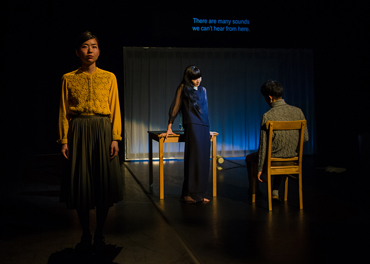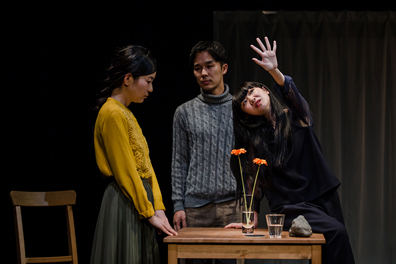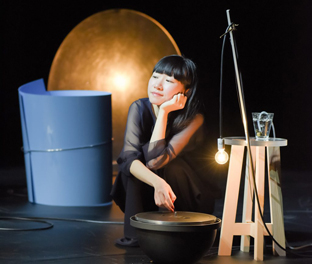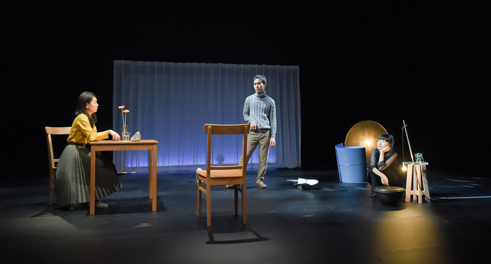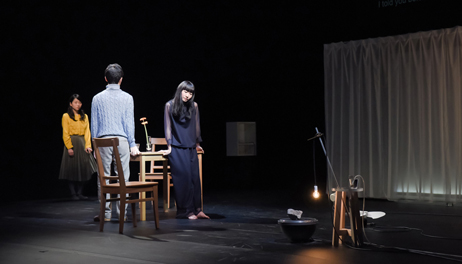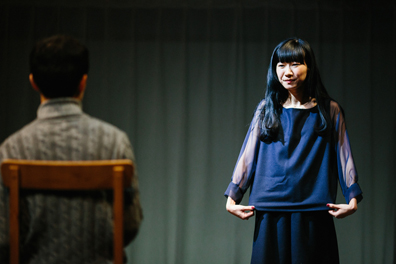 Extreme Quiet & Trauma Acoustics
Extreme Quiet & Trauma Acoustics
Cheltfisch’s Time’s Journey Through A Room
published in Real Time, Sydney, July 2017Japanese theatre group Cheltfisch for the past decade has advanced a distinctive form of low-key theatre, centred on the minutiae of everyday life as expressed through the bodily presence and vocalised phraseology of unassuming characters. Far from the heady heights of kabuki’s super-distilled hyper-graphic dramatic mechanics—frozen mie poses, choreographed fights, time-stretched logistics and musically mannered declamation—Cheltfisch has consistently sought to observe how people behave in the everyday, and how an actor can embody and channel that observation. In the end, a similarly stylised mode of performance results, with actors extemporising infinitesimal ticks and turns to frame a performance of how nobodies do nothing.
Time’s Journey Through A Room (2016) continues this approach wherein the actors perform with palpable restriction, moving to an invisible logic which delineates their physical presence, their vocal projection, and their occupation of the stage. Three characters convene dramaturgically: a man, his new girlfriend, and his recently deceased wife. Their interconnection is subtly and gradually revealed through a series of unfolded exchanges similar in tone to the cine-novels of Alain Robbe-Grillet. The trio simultaneously inhabit their past and present, as well as our conjoined present through their act of narration. Yet unlike Grillet’s spatio-temporal mosaics which continually reassemble the fictive potentialities of a relationship (as in the ghostly memories dissected throughout Hiroshima Mon Amour and Last Year In Marienbad), Time’s Journey Through A Room is anchored in the extended passage of grieving which grips the man, embodies the dead woman, and hovers in front of his new girlfriend. He hardly speaks; the ghost vocalises over 80% of the play; and the new girlfriend functions as both book-ending chorus and a occasional device for allowing the man to open up to her and disclose the weight he bears grieving his deceased wife.
All this could easily be handled by any of our state theatre companies—indeed grieving and mourning has become a millennial trope for ‘serious theatre’ and arthouse cinema desirous of respectability through dramaturgical depth. Mostly I find it tiresome and sappy. Conversely, Cheltfisch’s theatre craft demonstrates an almost radical means by which one can handle such material deftly and delicately without resorting to heavy-handed humanism. Crucially, this is done through possibly the most overlooked signifying level in stagecraft: sound design. Now, many would aver that in a glutted epoch of international festivals trumpeting innovation in the live arts, we have abundant creative sound design in contemporary theatre. As my ears hear it, we don’t. We have a surfeit of cheap dark ambient texturing, boringly obvious pop song blasting, and look-at-me audiovisual triggering resulting from excess lighting and projection. How does Cheltfisch’s play avoid this, or provide an antidote to these clichéd modish options?
Firstly, Time’s Journey Through A Room is an extremely quiet production. It employs soft vocal delivery as a key metric for balancing all other sound. The result is a contra-enunciated mode of theatrical staging. All sense of volume—and consequent spatialization and dramatization—is contained within and upon the stage. Counter to a legacy of modernist theatre craft which trades in pseudo-revolutionary wall-breaking and audience-assaulting, Time’s Journey resolutely remains upon its stage, forcing the audience (key word here) to audit the action not as something entering the auditorium, but as something irrevocably tied to a zone beyond our grasp. The symbolism seems clear to me: the story’s thematic drive centres on the new girlfriend straining to hear through the man’s silence to what he doesn’t say but which he hears continually, i.e. his deceased wife’s thoughts and voice. Typical of Japanese integrated holistic design (as opposed to European structured hierarchical design) the softness of sound simultaneously springs from the core impulse of theatre’s voicing of narrative upon a stage, and spirals through a circular inversion of those mechanics to intensify their effect. If theatre is essentially about voicing a story, then Time’s Journey materially adheres to this formal stricture.
Secondly, an audiovisual space is grafted and grown like a mimetic eco-system around the controlled vocal projections of the three actors. A range of lighting sources are distributed upon and above the stage, creating a matrix of ‘hot spots’ where light is registered by action or appearance. Various lamps, lights or bulbs will occasionally come on slowly, or an ‘off-stage’ spot or an under-lit background scrim will illuminate an actor. The means for the lighting is unaffected and unshowy: all the stage props are low level domestic objects (lights as well as a water hose, a pedestal fan, a rotating turntable) while the lighting design is rudimentary and conventional. But the point lies in the rhythm as these objects fade up and fade down, switch on or off, spring into motion or rest. True to Japanese synchronism, their presence constitutes a parallel Animist energy channel, where objects breathe of their own accord, cycling through passages and moments which drift into and out of synch with what appears to be narrative direction. Never does the lighting stray into arch dramatic synchrony. Further to this, the objects’ accompanying sounds synchronise or don’t synchronise to these slow arcs and momentary pulsations of light. They create a sonic cartography of dramatic timing which sets up relations to the lighting on one hand, and to the narrative action on the other. The transitions between these energy channels is elegant, like a breeze subtly moving a curtain (which actually occurs a few times too). Thus, the stage embodies a conjoined breathing which fuses with the breathing of the actors. Once one perceives this integrating momentum, one can then notice that even the actors’ movements across the stage (especially the man’s strange gestural catatonia with his back often facing the audience) are responsive to this audiovisual eco-system which the stage articulates and enacts.
Thirdly, the audible sound design follows this spatial logic. Sound textures fade up and down in cycles or pulses, sometimes recognisable as atmospheres, other times readable as abstract tones. It could appear to be affected sound art until one acknowledges the purpose of these lowercase textures: they represent—and activate—the sounds present in a domestic space when speech is halted, repressed, drained. Air-conditioning hum, fridge buzz and TV screen whine are all evoked. Impressively, this aural catalogue returns the hyper-stylised sonics of late 90s onkyokei related musics (from Otomo Yoshihide and Sachiko M to Toshimaru Nakamura and Ryoji Ikeda) to the originating electro-acoustic fields which inspired those musicians. It makes sense: if Japanese social interaction is based around a comparative reduction in vocalization, sounds of the enclosing and surrounding spatial environments are bound to become extended, pregnant, and foregrounded. Time’s Journey Through A Room is a play which speaks to this human-environment interaction grounded in cultural specificity.
Following through with an acknowledgement of the play’s Japanese context, Time’s Journey Through A Room’s core strength resides in its grappling with various private and public approaches to grieving and mourning in the aftershocks of 3/11 Japan. Trauma ultimately silences people. They become catatonic, insular, repressed, incoherent, isolated. Their experience territorialises their separation from those who do not or did not share identical experiences. Many Japanese artists have grappled with the inability to voice perspective following 3/11, questioning the role of artists in such situations, and how artists if at all could reflect upon ongoing states of trauma. It’s a no brainer to note the dual meaning of aftershock, applying equally to ground conditions following an earthquake and the mental disequilibrium suffered following a severe upset to an individual. In earthquakes and similar deafening moments of destruction, the silence that follows is always devastating—but only because it’s the first time maybe you become conscious of the non-sound that surrounded you everyday before the destabilizing event. Time’s Journey Through A Room threads those two zones together, deliberately stalling closure in order to retain the heightened sensations of feeling which attend trauma. The fact that the play acoustically achieves this is profound.
Text © Philip Brophy. Images © Cheltfish.

